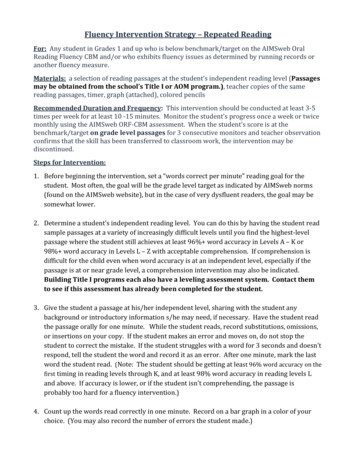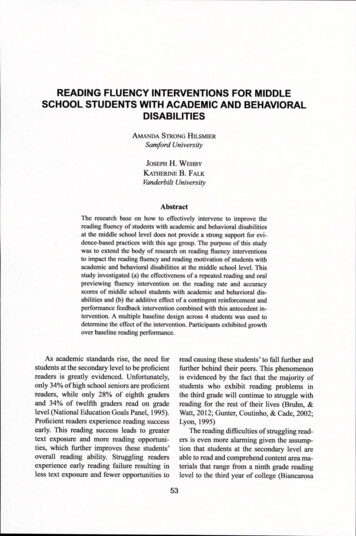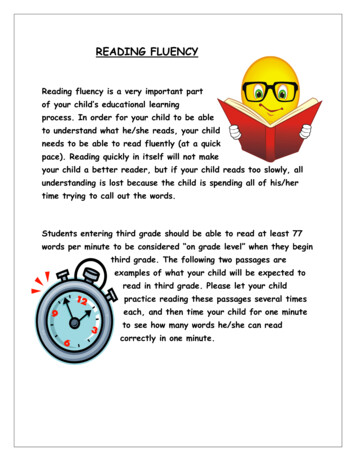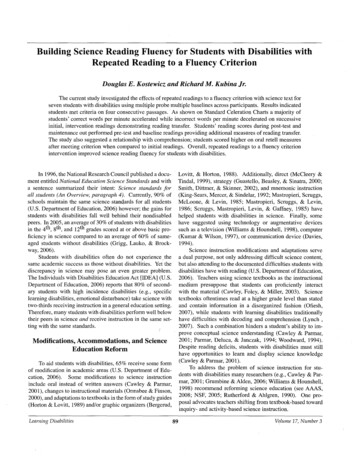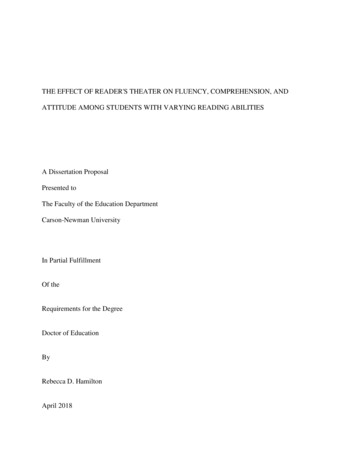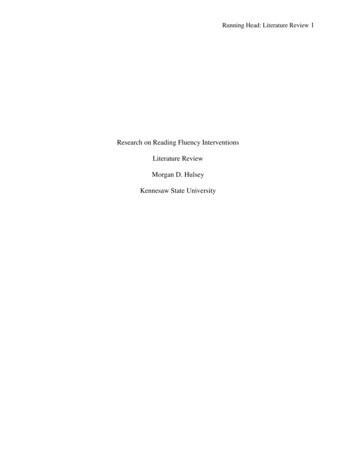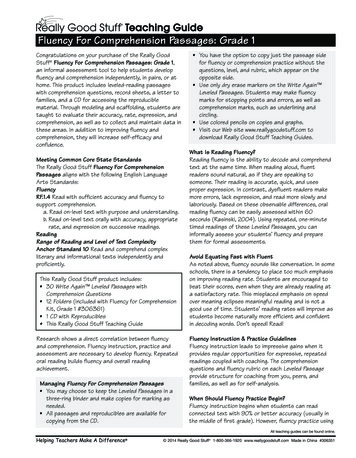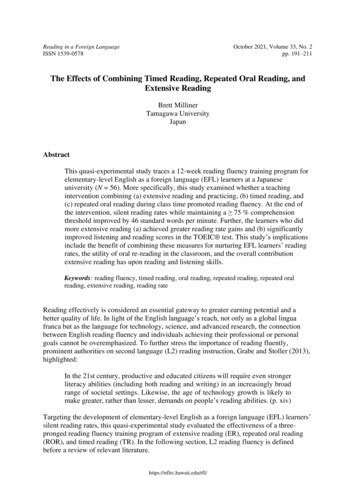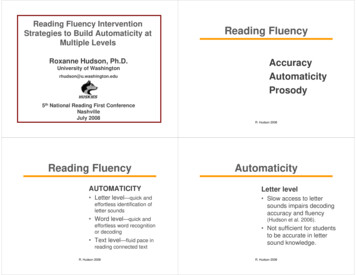
Transcription
Reading Fluency InterventionStrategies to Build Automaticity atMultiple LevelsRoxanne Hudson, Ph.D.University of Washingtonrhudson@u.washington.eduReading FluencyAccuracyAutomaticityProsody5th National Reading First ConferenceNashvilleJuly 2008R. Hudson 2008R. Hudson 2008Reading FluencyAutomaticityAUTOMATICITYLetter level Letter level—quick and Slow access to lettersounds impairs decodingaccuracy and fluencyeffortless identification ofletter sounds Word level—quick andeffortless word recognitionor decoding Text level—fluid pace inreading connected textR. Hudson 2008(Hudson et al. 2006). Not sufficient for studentsto be accurate in lettersound knowledge.R. Hudson 2008
AutomaticityAutomaticityWord levelText level Slow decoding impairsunderstanding Cognitive load is reducedas automaticity isincreased Cognitive resources canbe devoted tocomprehension Refers to the fluidity oftext reading, including therate of reading Typically measured incorrect words per minute(CWPM) Allows attention to focuson the connectedness oftextR. Hudson 2008R. Hudson 2008Improving Reading FluencyImproving Reading FluencyThe Bottom LineAs with any skill that requires anindividual to coordinate a series ofsmaller actions to create a unifiedprocess, it is practice that allowsthe learner to develop expertise.We will focus on practice thatimproves automaticity at the letter,word, and text level in order toreduce the readers’ cognitive loadand increase his or her readingcomprehension.(Kuhn & Stahl, 2002)R. Hudson 2008R. Hudson 2008
What the research says A meta-analysis of repeated readingsresearch by Theirran (2004) found that theseelements are critical for success:Timed Repeated ReadingsR. Hudson 2008 Can be used to increase automaticity with Letter sounds Sight Words Decodable Words Connected Text Should only be used with students who areessentially accurate, but slow. Should not be used with students who are notaccurate or who are already fluent. Are not appropriatefor useR. Hudson2008 with all studentsTimed Repeated ReadingsTimed Repeated Readings Assess struggling students to see what the areasof difficulty are Letter sounds appropriate for grade level,including digraphs Word families Sight words Connected text If using timed repeated reading with levels lowerthan connected text, ensure there is a connectionbetween the levels of practice. Much more powerful if students read passages toan adult (ES 1.37) rather than a peer (ES .36) Instructors should provide direct correctivefeedback after every session Much more powerful if students read until theyreach a rate and accuracy criterion (ES 1.78)rather than a set number of times (ES .38) If a student is accurate but slow, then timedrepeated reading is a good choice for him or herR. Hudson 2008 Practice in letter sounds Words with those letter sounds Sight words at a similar reading level (ifdesired) Connected text with those decodable and sightwordsR. Hudson 2008
Timed Repeated Readings: Schedule Best if done individuallyCan be done with groups up to 3At least 3 times a week5 to 10 minutes per studentTimed Repeated Readings: Goals Isolated Letter Sounds 60 cspm Isolated Words or Connected Text Grade 1Grade 2Grade 3Grade 4Grade 5Grade 6 40-55 cwpm90-100 cwpm110-115 cwpm120-125 cwpm130-140 cwpm150 cwpmR. Hudson 2008R. Hudson 2008Timed Repeated Readings: MaterialsTimed Repeated Readings: Materials Materials can be purchased or teacherscan make their own It is important that the materials follow a sensible progression thatsystematically addresses the areas that needto be worked on, increase in difficulty in small steps, are organized so that teachers and studentscan easily use them, and are at the appropriate level to meet thestudent’s needs.R. Hudson 2008 Letter sounds timing sheets go from simpleto more difficult in sequence that matchesreading intervention materials. Words timing sheets consist of increasinglydifficult sight words or decodable wordsthat use letter sounds.R. Hudson 2008
Timed Repeated Readings: Materials Connected text can come from anywhere:Timed Repeated Readings: MaterialsMaterials Organizationdecodable books, leveled books, corereading program stories, etc. As long as it is at the student’s instructional(90-95% accuracy) or independent (95% accuracy) reading level, any text can be used.R. Hudson 2008R. Hudson 2008Binder of Student MaterialsBinder of Student Materials Can keep graphs infront cover Separate sectionsfor sounds, words, & text. Mark individual studentmaterials with post-itsor colored tabs.R. Hudson 2008R. Hudson 2008
Binder of Teacher MaterialsR. Hudson 2008R. Hudson 2008R. Hudson 2008R. Hudson 2008
Letter Sounds Available to Download Go to www.fluentreader.org Click on the materials and programs linkR. Hudson 2008R. Hudson 2008Letter Sounds Available to DownloadR. Hudson 2008R. Hudson 2008
These materials are availablefrom the state of Florida Online: Go tohttp://www.fldoe.org/workforce/pdf/products catalog.pdfBy Phone: Call 1-800-342-9271R. Hudson 2008Great site to get your own readingpages of connected text made:R. Hudson 2008Okapi Tool: The website (www.interventioncentral.com) isvery helpful in the areas of CBM, RTI, positivebehavioral support, reading, writing, and math The name of the tool is OKAPI! The InternetApplication for Creating Curriculum-BasedAssessment Reading Probes kapi/okapi.phpR. Hudson 2008From kapi/okapi.phpR. Hudson 2008
Okapi Tool:Okapi Tool:From kapi/okapi.phpR. Hudson 2008From kapi/okapi.phpR. Hudson 2008Teacherversion of thetimingChild versionof the timingR. Hudson 2008R. Hudson 2008
For example a first grader Accurate but slow in all of the single lettersoundsFor example a first graderRecommendations: Letter pages that systematically practice Inaccurate on digraphs Accurate but slow on decoding CvC wordswith letter sounds Accurate but slow in text with CvC andsimple Dolch wordsR. Hudson 2008single letter sounds. Word pages that systematically practiceCvC words with those sounds Connected text with those words andsimple Dolch WordsR. Hudson 2008Letter Sounds ExampleOne page of each:8. or, ing, ar, ir9. wh, ur, er, ow (longp, c, t, l, short Io)g, d, k, n, short o10. oa, ee, ea, aik, b, j, z, short u11. ay, igh, oo, oi12. kn, wr, ewv, y, w, x, short eMastery Test: Single 13. ph, ui, ou14. Reviewletters15. Mastery Test: Allqu, th, ch, sh, ckSoundsR. Hudson 20081. m, s, r, f, short a2.3.4.5.6.7.R. Hudson 2008
R. Hudson 2008R. Hudson 2008Blendable SoundsFor example a second graderA reminder Whenever teaching or practicingindividual letter sounds, be sure to model,teach, and have the students produceblendable sounds.uhR. Hudson 2008 Fluent in single letter soundsAccurate but slow on digraphsFluent on reading CvC wordsAccurate but slow on decoding words withblends and digraphs. Fluent in simple text primarily made up ofCvC words. Accurate but slow in text with digraphs andblends.R. Hudson 2008
For example a second graderRecommendations: Systematic practice in digraph sounds. Systematic practice in words with thosesounds and with blends Connected text with those words andcommon Dolch WordsFor example a third grader Fluent in single and digraph letter sounds Fluent on reading CvC words Accurate but slow on decoding words withblends and digraphs. Fluent in first grade text Accurate but slow in second grade text.R. Hudson 2008R. Hudson 2008For example a third graderTimed Repeated Readings:Letter, Word, and Text LevelRecommendations: Systematic practice of words with blendsand digraphs, moving to multisyllabic words Connected text at the second grade levelwith the same patterns as the words thatgets increasingly difficult.R. Hudson 20081.2.3.4.5.6.7.8.9.Preview material to be readReview Graph and Set Goal for SessionStudent Reads for 1 minuteInstructor Listens and RecordsInstructor Provides Constructive FeedbackCalculate ScoreGraph DataDetermine if Goal is metCelebrate or SupportR. Hudson 2008
Timed Repeated Readings:1. Preview Material The student practices the timing probe. The instructor models the correct responses (i.e.,correct pronunciation of isolated sounds or ofdifficult words) for any unknown items beforebeginning the timing.Timed Repeated Readings:2. Review Graph and Set Goal for Session Make sure to use the graph during every sessionwith the student to provide critical informationabout progress and motivation. The student and instructor look at the graph ofthe previous session to review progress made todate and set a progress goal for today’s session. Ask the student to state what he or she will workto accomplish (e.g., I will read 5 more words. Iwill make fewer mistakes).R. Hudson 2008R. Hudson 2008Timed Repeated Readings:3. Student Reads and4. Instructor RecordsReviewGraph andSet Goal forSession After instructor modeling,the student is asked to readas many sounds or wordsas possible in one minutefrom his or her copy of thereading materials. The instructor times thestudent for 1 minute.R. Hudson 2008R. Hudson 2008
Timed Repeated Readings:3. Student Reads and4. Instructor Records While listening, theinstructor circles all errorson the instructor's copy ofthe page with a dry erasemarker or wipe-off pen. In addition, the instructoroffers the correctpronunciations during thetimed reading.Timed Repeated Readings:5. Constructive Feedback The instructor and student review the student'sperformance on the task First, the instructor provide positive feedback. Next, the instructor provides correctpronunciations for errors and student practicesthe correct pronunciation of sounds and words.R. Hudson 2008R. Hudson 2008Timed Repeated Readings:6. Calculate ScoreTimed Repeated Readings:7. Graph Data To determine the number of words the studentread, look at the number of words at the end ofthe last complete line he read and then count onto the last word read. Explain to the student that he or she will read asmany times as it takes to reach that goal withouttoo many mistakes. Then count the number of errors. When the goal is reached, you will celebrate withthe student and give him or her a new timingpage. Subtract the errors from the total words read.This yields the fluency score that will be graphed,the number of correct words read per minute.R. Hudson 2008R. Hudson 2008
Timed Repeated Readings:7. Graph Data You will use the graphs with the student toprovide critical information about progress andmotivation. Record the student’s score in the correct weekand day, with the number of correct words perminute/errors. On the graph, find the correct week and day andput a dot on the right horizontal line for the datapoint.R. Hudson 2008R. Hudson 2008Timed Repeated Readings:8. Determine if Goal is Met8. Determine ifGoal is Met If a student reads at or above the number ofcorrect words (sounds) per minute marked as hisgoal with fewer than the number of errors, thenshe has “made his goal”. This determination is made based solely on thedata. A student may make his goal in onesession or seven. Either way, the student moveson to a new passage.R. Hudson 2008R. Hudson 2008
Timed Repeated Readings:9. CelebrateTimed Repeated Readings:9. CelebrateIf the student met the goal, Celebrate!!If the student met the goal, Celebrate!! In addition to using the graph, put into place amotivation plan Lunch with teacher Banana Split In addition to using the graph, put into place amotivation plan Lunch with teacher Banana Split PizzaR. Hudson 2008R. Hudson 2008Timed Repeated Readings:9. CelebrateTimed Repeated Readings:9. CelebrateIf the student met the goal, Celebrate!!If the student met the goal, Celebrate!! In addition to using the graph, put into place amotivation plan Lunch with teacher Banana Split Pizza Reach for the Stars In addition to using the graph, put into place amotivation plan Lunch with teacher Banana Split Pizza Reach for the Stars Add shapes to a bulletin board for each goalreachedR. Hudson 2008R. Hudson 2008
Timed Repeated Readings:8. Determine if Goal is MetTimed Repeated Readings:9. Support If a student read below the number of correctwords (sounds) per minute marked as his goal orhad more than the number of allowed errors,then he has not “made his goal”. If the student has not met the goal, providesupport. Many students who struggle in school attributefailure to lack of ability or the task being too hard.As you provide support to the student, be sure toattribute reaching his goal to hard work and hisfailure to reach the goal as a result of not workinghard enough. You may want to discuss strategies to use,additional practice, or other ways to help himselfreach the goal.R. Hudson 2008 The student will read that page again during thenext instructional session and continue with thatpage until she reaches the goal.R. Hudson 2008“The goal of helping children learn torecognize words quickly and easily is toensure that word recognition will feed ratherthan compete with comprehension.The goal of explicitly and systematicallyteaching children to understand and usephonics is to bring them to that point faster.”Questions?rhudson@u.washington.eduA list of resources and materialsare found on handout 6 of yourpacket(Adams, 2001, p. 78)R. Hudson 2008R. Hudson 2008
Timed Repeated Readings: 3. Student Reads and 4. Instructor Records While listening, the instructor circles all errors on the instructor's copy of the page with a dry erase marker or wipe-off pen. In addition, the instructor offers the correct pronunciations during the timed reading. R.
